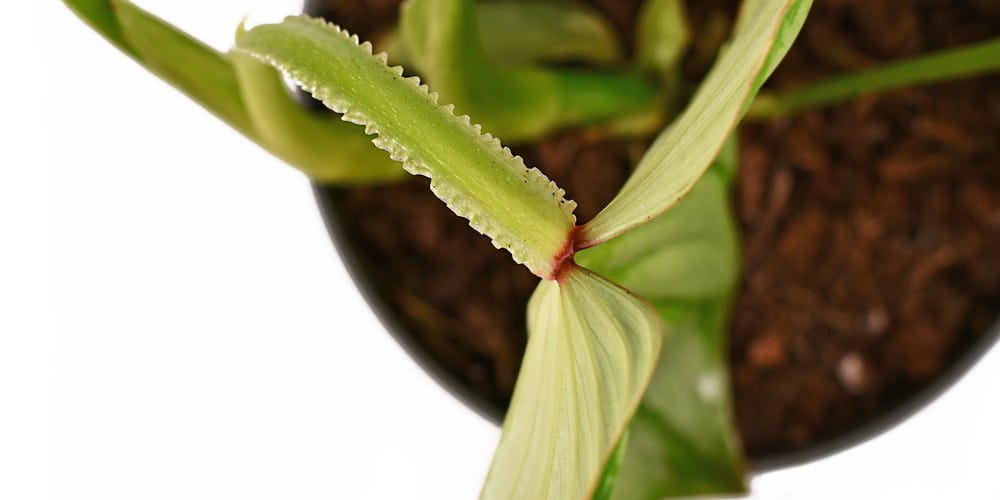Philodendron mamei is a beautiful creeping vine with large, dark green leaves, making it a popular house plant. It grows well in the home and will flower indoors under ideal conditions. Let’s look at how to grow and care for a philodendron mamei.
What is a Philodendron mamei?
Philodendron mamei is a popular tropical plant that has beautiful foliage. They are straightforward to care for and perfect for beginners. Philodendrons are tropical plants from the Araceae family, and they grow in a variety of habitats, with most species occurring in rainforests. The Philodendron Mamei originates from the Ecuadorian rainforests, where it’s able to climb taller trees.
Philodendron mamei is a flowering plant that produces small flowers at the base of its leaves. The flowers are white, green, or yellow with 2½-inch long floral tubes. Blooming only occurs on plants that are at least one year old.
Philodendron Mamei Care
Philodendron Mamei is easy to care for, as long as you get the basics right. It’s an air-purifying plant that looks great in the home or office. Here are some tips to help you grow a thriving philodendron mamei:
Propagation
If you already have a philodendron mamei, you can propagate it by taking cuttings of the vines during late spring or early summer. These cuttings should be at least eight to ten inches long and need to be treated with root hormone before being planted in individual pots filled with potting soil.
Temperatures
Philodendron mamei will grow best if they are kept around 70 degrees Fahrenheit during the day and no lower than 50 degrees at night. Be careful not to leave your plant in a draft from an open window or from air conditioning, or it will suffer.
You can grow philodendrons outdoors if you live in USDA zones 9 to 11.
Watering requirements
This beautiful house plant should be given a thorough watering every seven to ten days during the spring and summer months. While growing, you may need to water it more frequently but never let the soil become soggy. During the winter months, you should reduce your watering to once every two weeks.
Sunlight needs
Philodendron mamei need plenty of light for at least six to ten hours per day during the spring and summer months. Any windows in your home that receive bright sunlight will be perfect for growing philodendron mamei. Be careful not to leave your plant in the full sun, or it may get sunburnt, which causes brown patches to develop on the foliage.
If your plant is not receiving the recommended amount of sunlight, it will become leggy and weak. Philodendron mamei does well in low to moderate light during the fall and winter months.
Plant Pests and Diseases
Philodendron mamei is susceptible to attack from spider mites, mealy bugs, aphids, and thrips. These pests can all be controlled by insecticidal soap or an appropriate pesticide. If a plant has a bad case of spider mites, you will notice fine webs between the leaves and stems of your philodendron mamei.
Root rot can be a problem if too much moisture is allowed to collect in the soil. Leaves wilting or curling upwards may indicate issues with lighting or overwatering.
Humidity
philodendron mamei requires a humidity level of around 50 percent or higher for optimum growth. If you can’t easily find a location that meets this requirement, you need to take steps to increase the moisture in the air as much as possible. This can be done by regularly misting your philodendron with water. Alternatively, keep the plant in a room, such as a bathroom, shower room, or kitchen, where the air is warm and very moist.
Soil
This houseplant does best in a rich, well-drained potting soil containing plenty of organic matter like peat moss, perlite, or leaf mold. Philodendrons thrive in slightly acidic soil with a pH range of 5.0 to 6.0. They will benefit from an application of all-purpose fertilizer during the spring and summer months.
Conclusion
Philodendron mamei is a beautiful houseplant that can add color and interest to your home or office. It makes an excellent addition to any partially sunny window but needs to be kept moist at all times except during the winter months when watering should be reduced.
The plant requires average monthly fertilizer applications and will grow best if you mist its leaves with water daily to improve humidity.

